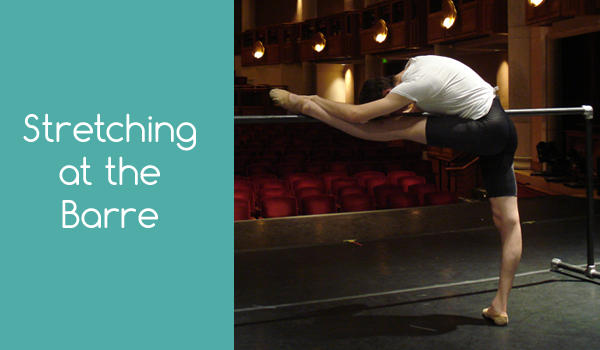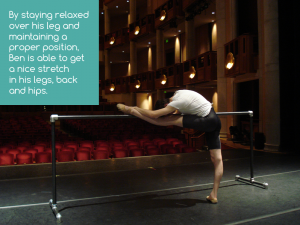Having a stretching routine is a great thing to have for both students and professionals. However, poor stretching habits can lead to fewer, and possibly unwanted, results when it comes to ballet technique. Let’s take a look at a few examples of how to properly stretch your muscles at the barre.
Tips for Proper Stretching at the Barre
- Try to keep your legs equally turned out and remember you’re not just stretching the leg on the barre, but also stretching and training the muscles of your standing leg.
- Try to keep your hips square to the direction that you’re stretching. Since practically all ballet positions require your hips to be square to a specific direction, this only makes sense if you want to use your flexibility in context of a class or performance.
- Be sure not to tuck your hips under or out, just nice and straight on top of your standing leg.
- As you stretch over your leg, try to relax as much as possible. If you contract your muscles, you’re keeping them from stretching further!
- Be aware of your breathing, taking deep breathes as opposed to holding your breath so more oxygen can get to your muscles.
- Even if you’re capable of having your leg on a higher barre correctly, you can still use a lower barre to do all sorts of other stretches that target other muscle groups, only possibly with a lower leg.
- While it’s important to keep up with your stretching routine and holding each stretch long enough, don’t hold so long that you overstretch and risk injury.
Is the Barre Too Tall?
 Sometimes dancers may stretch at a barre that is too tall for their level of flexibility. While it may seem like you’re accomplishing something by hiking your leg up to the top barre with your hip raised and leg bent, you may want to think again! Stretching is an action, not an accomplishment. If you can’t stretch on a barre with a relatively straight leg and square hip, the barre is likely too high. Some dancers may argue this and refuse to try a lower barre, but if they gave a lower barre a chance, they might actually find that the stretch is more beneficial and they can eventually move back up to the top barre.
Sometimes dancers may stretch at a barre that is too tall for their level of flexibility. While it may seem like you’re accomplishing something by hiking your leg up to the top barre with your hip raised and leg bent, you may want to think again! Stretching is an action, not an accomplishment. If you can’t stretch on a barre with a relatively straight leg and square hip, the barre is likely too high. Some dancers may argue this and refuse to try a lower barre, but if they gave a lower barre a chance, they might actually find that the stretch is more beneficial and they can eventually move back up to the top barre.
If you still can’t accomplish the points listed above on the lower barre, try out a chair. You don’t have to stretch exclusively at a barre just because you’re taking a ballet class and a chair provides a nice height about 2 feet off the floor.
Remember Your Standing Leg
One of the most common mistakes that beginners and amateurs make while stretching (and often in other areas of technique) is forgetting about your standing leg. Because the leg on the barre is the one that “moved” and is eye-catching, a beginner may think that is where the focus needs to be. While the focus does need to be on the leg on the barre, it also needs to be on your standing leg because you are in fact stretching and training muscles in both legs!
By being aware of your bottom leg, you are setting yourself up to actually use your flexibility in context of class or a performance. Without a strong and stretched standing leg you will find it difficult to hold and dance through nice classical positions. Simply switching legs on the barre is not the same.


